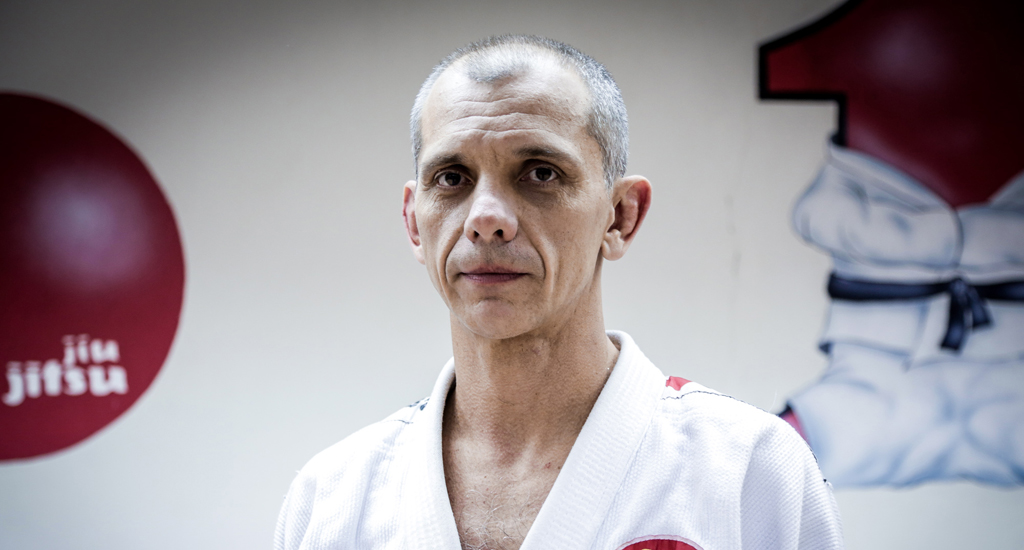Introduction: The De La Riva Guard
The De La Riva guard is a key technique in Brazilian Jiu-Jitsu, providing exceptional control and mobility against a standing opponent. Developed by Ricardo De La Riva, this guard is particularly effective for practitioners aiming to unbalance and attack an aggressive opponent.

In this article, we explore not only the fundamentals of this technique but also advanced strategies to incorporate it effectively into your game.
What is the De La Riva Guard?
De La Riva guard involves the practitioner on the bottom wrapping one of their legs around the opponent’s standing leg, creating a leverage point. The foot hooks behind the opponent’s knee while the hand controls the ankle, ensuring a tight grip. The other hand plays a crucial role in manipulating the opponent’s sleeve or collar, keeping them off-balance and vulnerable to attacks.
This guard is especially effective against opponents who aggressively seek to pass or maintain a standing position. It allows you to slow their progress while creating opportunities for quick transitions into attacks or sweeps.
The Basics of the De La Riva Guard
- Ankle Control: Firmly grabbing the opponent’s ankle not only prevents their escape but also prepares angles for attacks. Proper ankle management is essential for maintaining the connection and dictating the opponent’s movements.
- Hooking Foot: The placement of the foot is crucial for unbalancing the opponent. A well-positioned hook forces the opponent to constantly readjust, giving you the time and space to plan your next move.
- Collar or Sleeve Control: Using your free hand to control the collar or sleeve allows you to manipulate the opponent’s posture, creating openings for sweeps or submissions.
Techniques and Sweeps from the De La Riva Guard
- Basic Sweep: This classic sweep uses a combination of the hook and ankle control to topple the opponent. By pulling the ankle and pushing simultaneously, you can easily unbalance the opponent and reverse the situation.
- Berimbolo: This advanced technique involves rolling under the opponent to take their back. The Berimbolo, though complex, is a formidable option for experienced practitioners, quickly turning a defensive situation into a dominant position.
- Single-Leg De La Riva Sweep: By grabbing the opponent’s other leg and combining ankle control with the hook, you can execute an effective sweep that places the opponent on the ground, allowing you to establish a dominant position.
The Advantages of the De La Riva Guard
- Dynamic Control: The De La Riva guard excels at maintaining a safe distance while allowing you to create offensive opportunities. This dynamic control prevents the opponent from dictating the pace and enables you to direct the exchange.
- Versatility: Adaptable to different types of opponents, this guard offers a wide range of strategies to counter various styles, whether against powerful or fast grapplers.
- Effective Transitions: Due to its numerous variations, the De La Riva guard allows you to easily switch from a defensive position to an offensive one.
Examples of Variations
- Reverse De La Riva Guard: By reversing the hook, you can slip under the opponent for more dynamic sweeps or attacks. This variation is ideal for practitioners looking to neutralize aggressive opponents with an offensive approach.
- De La Riva with Lasso: This variation adds an extra layer of control. Make it even harder for the opponent to escape. Use it to create favorable situations for submissions like the triangle or armbar.
Exercises to Improve Your Position
- Ankle Control Drills: Strengthen your ability to maintain a firm grip on the ankle, even under pressure. This control is key to preventing the opponent from breaking your guard and passing.
- Transitions to Berimbolo: Practice chaining the rotational and control movements necessary to execute a smooth Berimbolo. Mastering this transition will allow you to surprise opponents and take their back quickly.
- Unbalancing the Opponent: Train to constantly unbalance your opponent with the De La Riva hook. Create openings for immediate attacks or transitions to other positions.
Discover the origins of this guard in a video:
Check out this BJJ Hacks video where the De La Riva guard is discussed by its creator himself !
And finally, a video on different setups used by Meregali. Between De La Riva, Deep De La Riva, and X Guard, this is a must-watch video—over and over—to fully grasp the techniques!
Key Takeaways:
The De La Riva guard is an essential technique for any Jiu-Jitsu practitioner looking to improve their standing game and transition skills. Its ability to control, unbalance, and attack the opponent makes it a guard worth mastering. By working on the fundamentals and exploring the variations, you can expand your options and become a formidable opponent at any level.


